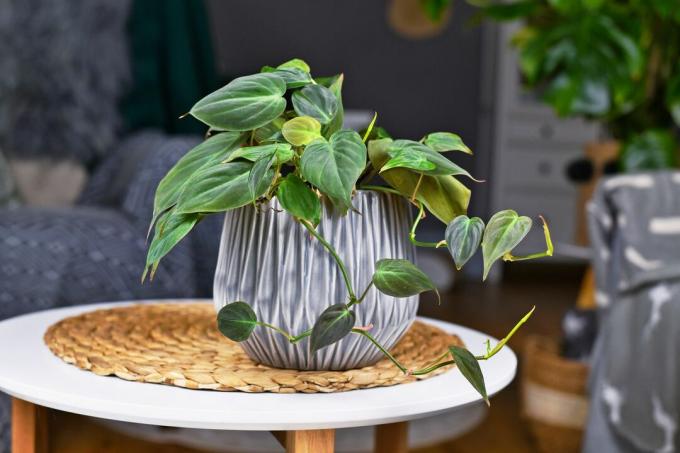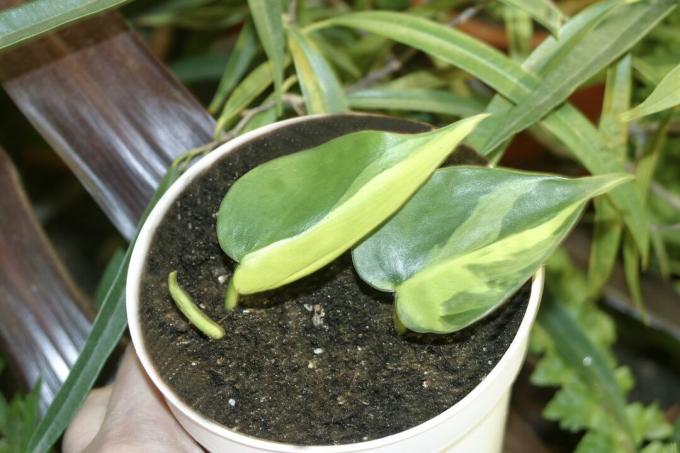the Philodendron scandens, also called climbing philodendron, can decorate the apartment as a climbing or hanging plant. How to properly care for and propagate the plant, you will learn from this article.

One of the easy-care foliage plants is the Philodendron scandens – if its location and climate requirements are met. In this article you will find an overview of the origin, the most beautiful varieties as well as care and propagation of the climbing philodendron.
"Contents"
- Philodendron scandens: origin and characteristics
- The most beautiful climbing philodendron varieties
- Plant Philodendron scandens: Location, soil and Co.
- Care of Philodendron scandens
- Overwinter climbing philodendrons
- Propagating Philodendron scandens
- Is the Philodendron scandens poisonous?
Philodendron scandens: origin and characteristics
The climbing philodendron (philodendron scandens, synonymous synonymous Philodendron hederaceum
) is an evergreen climbing plant native to Central America and the Caribbean, whose genus name Philodendron (ancient Greek philos =friend; dendron = tree) translated means "tree friend". In their natural habitat, these aroids (Araceae) grow in the shade of large trees or as epiphytes, even on their large neighbors.Under the best conditions, the climbing philodendron can reach a height of between 3 and 6 meters, whereby the plant, which climbs up the trunk of trees, is only slightly sprawling. the Philodendron scandens develops heart-shaped, velvety glossy leaves that can grow up to 30 cm long when old. The light to dark green leaves grow on a petiole up to 10 cm long. as climbing houseplant will the Philodendron scandens but not so big for us. It can be cultivated as a climbing plant on a trellis, as a traffic light plant or as a hanging plant. In very good conditions, flowering occurs only very rarely. In its homeland, the climbing plant forms flowers typical of the arum family with an inflorescence stalk, a bract and a spadix. Particularly striking are the long aerial roots that hang down from the plant and can reach a length of up to 6 meters in older plants in their natural habitat.
Tip: The window leaf (monstera) is also often referred to as a tree friend and as a philodendron and sold as such. When buying, it is therefore important to pay attention to the correct botanical name.
The most beautiful climbing philodendron varieties
Two philodendron varieties in particular were able to assert themselves with us:
- Philodendron scandens 'brazil': Will also be Philodendron scandens Called 'Variegata' and forms a conspicuous leaf pattern in light green or white in bright, not directly sunny locations. He is very easy to care for.
- Philodendron scandens 'Micans': The dark green, velvety leaves sometimes have a slightly reddish, conspicuous leaf edge.

Plant Philodendron scandens: Location, soil and Co.
As an original climbing plant in the shade of trees, a semi-shady to shady location is ideal for the Philodendron scandens well suited, whereby long, direct sunlight should be avoided. Too intense midday sun can cause sunburn, yellowing or browning of the leaves. The ideal growth temperature for the climbing philodendron is 20 to 25 °C, with a minimum temperature of 15 °C. In the temperate zone, it is advisable to keep the plant under glass or exclusively as a houseplant. In general, drafts should be avoided, otherwise the growth of the plant will be disturbed.
As a substrate is suitable for the Philodendron scandens a soil rich in humus and at the same time low in lime, as it is very sensitive to lime. At the same time, a loose substrate allows good soil aeration and thus reduces the risk of root rot. The prefers slightly acidic soils Philodendron scandens compared to neutral soils. A high-quality earth – like ours Plantura organic universal soil – offers the ideal basis for healthy and strong plant growth, as it can sustainably supply the plant with a high nutrient content and a high proportion of compost. Furthermore, because of a balanced proportion of coco pith, she is able to store enough water for the plants while maintaining a high level of soil aeration. In addition, a layer of pine bark can be applied or alternatively sour rock powder (from granite or basalt) can be mixed with the soil to keep the soil pH constantly slightly acidic keep.
Care of Philodendron scandens
the Philodendron scandens is a very hardy plant that requires little care with the right background knowledge.

It is important for the plant to be constantly supplied with water during the vegetation period - from April to October. the Philodendron scandens However, it uses relatively little water for its size. Therefore, there is a risk of waterlogging and thus root rot if watering excessively without sufficient drainage. The soil should therefore be tested for moisture with a finger test before each watering. Because the Philodendron scandens is very sensitive to lime, collected rainwater or mineral water, which is best at room temperature, is suitable as irrigation water. If the humidity is low, the plant can be sprayed occasionally with a little lime-free water - this ensures a good climate and at the same time cleans the leaves of dust.
During the growing season, the Philodendron scandens be fertilized every two weeks so that the plant has all the nutrients it needs for growth. If there is a nutrient deficiency, the leaves of the Philodendron scandens discolor and fall off, growth and new leaf formation also stop. To prevent this, a high-quality liquid fertilizer that is added to the irrigation water is particularly good. Our Plantura organic indoor and green plant fertilizer supports the growth of healthy and strong plants through a needs-oriented nutrient ratio and a resource-saving lower phosphorus content. The addition of microorganisms promotes the absorption of nutrients from the substrate and sustainably strengthens root growth.
You should do this every one to two years Philodendron scandens repot, not only because the plant gets bigger, but also because every potting soil sags over time and micronutrients - not all of which are also present in fertilizers - run out. The tree friend indicates the need for a new pot by pushing many aerial roots out of the top of the pot and stagnating in growth overall.
The new pot should always be around 20% larger than the old one, especially for young plants. The best time for repotting is early spring from March, before the start of vegetation. The plant can be removed from its old pot and excess soil removed. the Philodendron scandens should then be placed in the new pot before the added soil is lightly pressed and well watered. At the same time, a new climbing aid can be used if the Philodendron scandens cultivated as a climbing plant. To do this, old shoots should be carefully detached from the old climbing aid before it is pulled out. You can then insert the new climbing aid before the shoots are attached to it with the help of a plant ring or a cord. It is important to ensure that there is enough space for future growth. Finally he can Philodendron scandens be returned to its location.

A topiary of Philodendron scandens is not necessary, because the foothills can easily be guided back to the climbing aid. If they become too long for the hanging plant, they can simply be cut off with sharp pruning shears. Disturbing, old and dry shoots and leaves can be cut off, as can diseased leaves.
Overwinter climbing philodendrons
During hibernation, the climbing philodendron should be moved to a cooler, draft-free location that is 16 to 18°C. A conservatory, a bright stairwell or little heated living rooms are suitable for this, for example. During the winter months, you should only water the plant sparingly, as water uptake is reduced. The root ball is allowed to dry out, but not dry out. Fertilization should be avoided completely.
Propagating Philodendron scandens
It is particularly easy to propagate the Philodendron scandens about cuttings. For this purpose, parts of the plant that have at least one leaf and roots can be used. The cut off parts of the plant can be placed in a pot filled with a soil-sand mixture and watered well. The pot can then be covered with a sheet of glass or cling film to create a micro greenhouse. In a warm place of ideally 25 °C, the parts of the plant will take root after just two to four weeks. The lid should be opened occasionally to prevent fungal infestation.

Is the Philodendron scandens poisonous?
the Philodendron scandens is mildly toxic because almost all parts of the plant contain calcium oxalate crystals as a natural protection against eating. Above all, the leaves of the Philodendron scandens often gnawed on by cats, which can lead to mild symptoms of poisoning and long-term damage to the kidneys. For humans, on the other hand, there are no cases of poisoning Philodendron- Known plants.
Do you like evergreen, exotic plants, but find flowering plants even more beautiful? Then read our article on A leaf.



